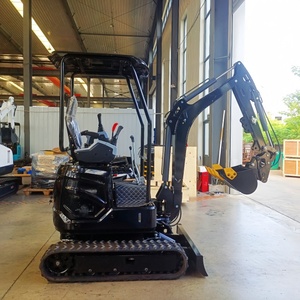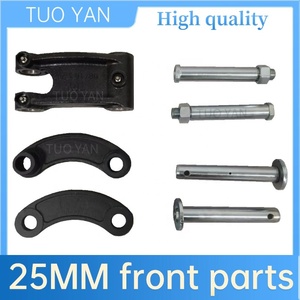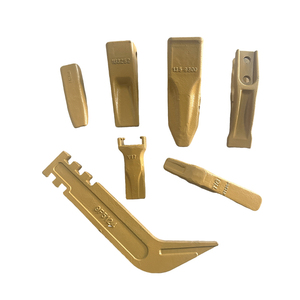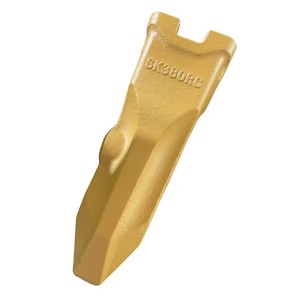
All categories
Featured selections
Trade Assurance
Buyer Central
Help Center
Get the app
Become a supplier

(1046 products available)




















































Digger pins are an integral part of an excavator bucket. The pins are used to connect the bucket to the digging arm or connector links. They make the entire digging mechanism work, allowing the hydraulic motor to move the bucket. Meanwhile, the pins also ensure the excavator bucket maintains its position when digging or holding material. Excavator bucket pins are usually made of steel and come in various sizes and designs to suit different types of excavators and buckets.
Digger bucket pins typically allow a limited range of movement. For instance, a typical excavator bucket pin will permit a movement range of up to 40 degrees. However, several degrees of freedom in movement are essential for the digging bucket to move and dig rotate freely.
If the bucket moves smoothly with the help of the pins, friction will be the only force that will wear them out. To avoid friction, grease can be used to allow the bucket to move freely. Implementing a regular lubrication routine is crucial to reducing friction and digger bucket pin wear.
Standard Digger Bucket Pins
Like most digger bucket pins, these are machined pins that connect the bucket to the linkage or arm. They have a hole on each end to secure them with a retaining clip or wire.
Greaseable Digger Bucket Pins
Unlike standard digger bucket pins, which are sealed, these pins have a grease fitting that allows for regular lubrication. The grease fitting reduces wear and tear, thus extending the lifetime of the bucket digger pins.
Quick Coupler Digger Pins
Quick coupler pins are used in excavators with a quick coupler system. This mechanism enables faster bucket attachment and detachment. The quick coupler system is commonly used in dynamic or production excavator models. These digger bucket pins have a more complex design than standard digger bucket pins.
Cat Digger Bucket Pins
These pins are specially designed to fit Caterpillar excavator models. Various digger bucket pin suppliers provide different designs and sizes to fit specific CAT excavators.
Some key specs can affect how well digging pins perform and fit when installed on the digger buckets.
Size and fit
Digger pins have a specific size and fit that match the mounting points on the excavator bucket and linkage system. The size and fit usually include the pin's length, diameter, and other unique features like grooves or collars. Proper fit is crucial for ensuring that the pins support the buckets securely and work efficiently with the excavator's movement.
Material
Digger pins are usually made from high-strength steel or alloy steel materials. The excellent strength and durability of these materials enable the pins to handle heavy loads and work in demanding excavation conditions over an extended period of use.
Load-bearing capacity
Digger bucket pins have a certain load-bearing capacity or weight rating. This indicates the maximum load or weight that the pins can support safely without bending, breaking, or failing. The load capacity of the pins must be matched to the excavator's size, weight, and the types of materials being dug to prevent premature wear or failure.
Surface finish
Digger bucket pins can have a specific surface finish, such as galvanized, painted, or powder-coated. This finish provides protection against corrosion and environmental damage, helping to extend the lifespan of the pins even when used in harsh or outdoor settings.
Maintaining digging bucket pins is vital to ensuring their continued performance and that of the excavator buckets. Regular maintenance prolongs the lifespan of the digging pins and helps avoid costly repairs that may arise due to pin damage.
Frequent Inspection
Users should routinely inspect the digger bucket pins. They should check for damages like cracks, bending, or any other signs of wear that could affect the pin's integrity and functioning. In case of noticeable deterioration, the users can replace them with new ones to prevent any risk of failure that can damage the excavator bucket or cause accidents.
Lubrication
Applying lubrication to the digger pins' loading points regularly is essential to enhance smooth movement and minimize wear. Users should also clean out bucket loading points to remove debris and dirt before applying grease or lubricant. With proper lubrication, the operator can allow for even more extended use of the digging pins while also prolonging the lifespan of both the pins and the excavator buckets.
Corrosion prevention
Users can significantly reduce the risk of corrosion damage to the digging bucket pins by applying protective coatings. They can apply anti-corrosive coatings to the pins after use or before long-term storage. During long-term storage, users should also keep the digging pins in a dry and well-ventilated place free of humidity. This type of environmental condition can lead to corrosion, reducing the pin's integrity and lifespan.
Digger bucket pins hold the digger's bucket and other attachments and allow them to rotate, tilt, and move. Here are some scenarios for digger bucket pins:
When selecting suitable digger bucket pins, a variety of factors need to be taken into consideration.
Match the size and specifications:
Ensure that the size and specifications of the bucket pin match the applicable excavator bucket. This includes checking the pin diameter, length, and other relevant parameters to ensure a proper fit and connection.
Material and durability:
Choose pins made of high-quality materials, such as alloy steel or heat-treated steel, to ensure their strength and durability. Select pins with suitable load-bearing capacities and wear resistance to withstand the stresses and operating conditions during excavation.
Design and features:
Consider the design and features of the pins, such as whether they possess self-lubricating functions or anti-wear structures, which can enhance their performance and longevity. Additionally, select pins that are easy to install and disassemble, facilitating maintenance and replacements.
Quality and reputation:
Choose pins from reputable brands and reliable manufacturers to ensure their quality and performance. Conduct research and comparisons to select manufacturers that have gained positive feedback and established a good market presence.
Cost-effectiveness:
Consider the cost-performance ratio of the digger bucket pins. While it is important to consider the budget, prioritize selecting pins that offer a good balance of performance, quality, and value for money to ensure the investment's effectiveness.
Q1: How do digger bucket pins work?
A1: Digger bucket pins work by providing a pivot point for digging buckets or other attachments to rotate. They are fixed to the machine arm and fit through the bucket's ear.
Q2: What are the types of digger bucket pins?
A2: The most common types of digger bucket pins are round head pins and hitch pins. Round head pins are also known as ROPS (Roll Over Protection System) pins. They are commonly used in the ROPS structures of vehicles and equipment, such as excavators. Round head pins have a round head that allows easy insertion and removal. On the contrary, hitch pins come with a u-shaped lock. These pins help secure the digging bucket or hitch to the excavator more firmly.
Q3: What materials are used to manufacture digger bucket pins?
A3: Steel is widely applied in the production of digger bucket pins due to its superior strength and longevity. Some heavy-duty digger bucket pins may be made of alloy steel.
Q4: How to choose suitable digger bucket pins?
A4: When choosing the digger bucket pins, buying users need to ensure that the sizes match the buckets or other attachments. They also need to consider the materials to suitable for their specific use conditions.